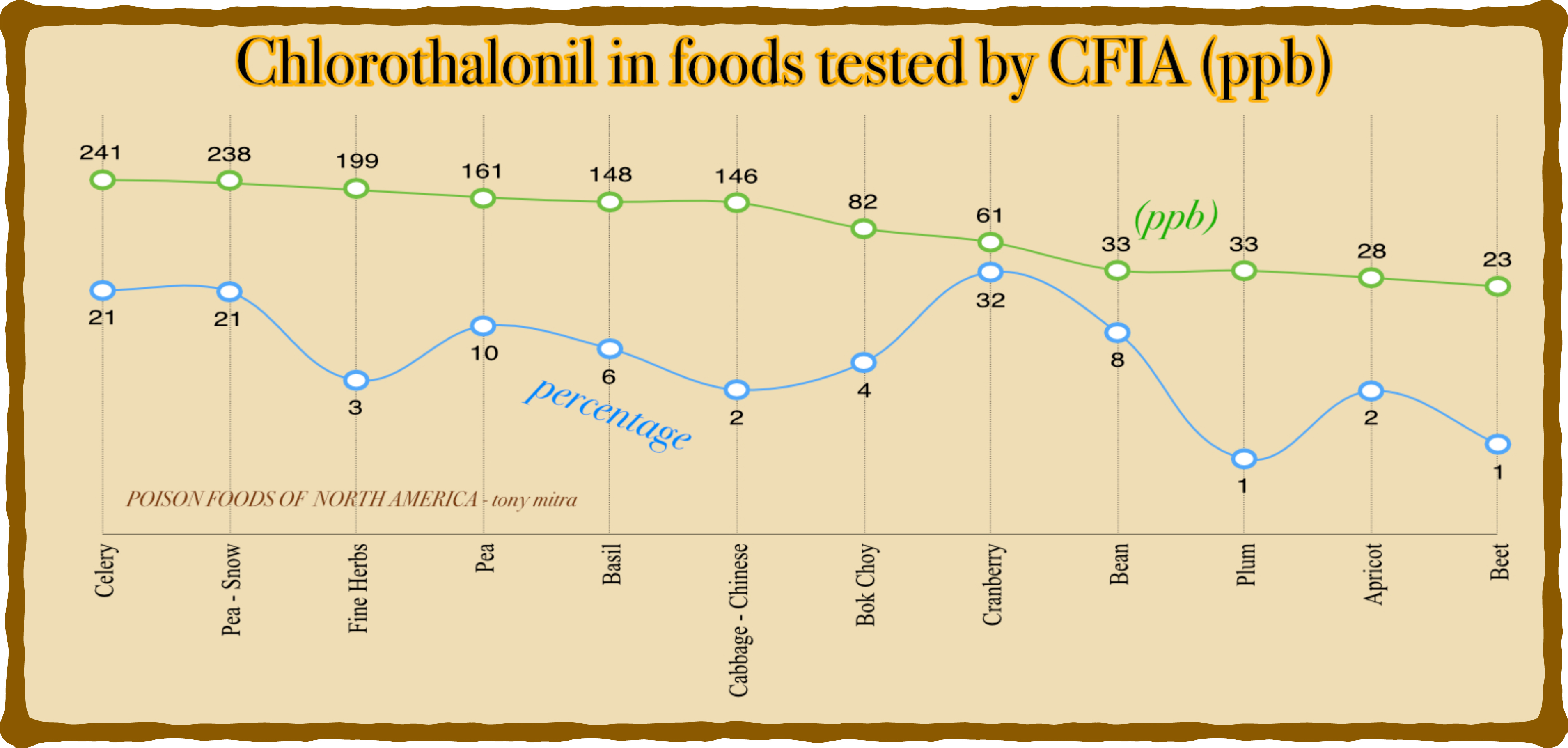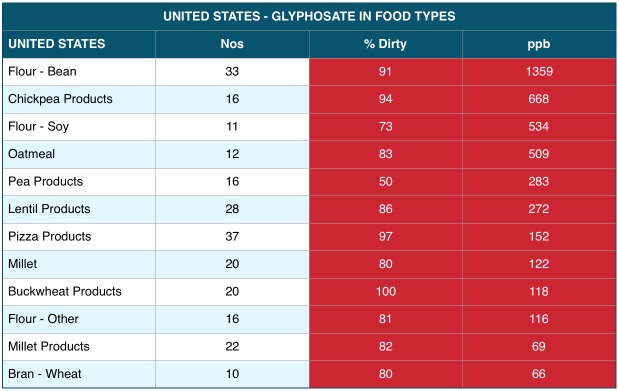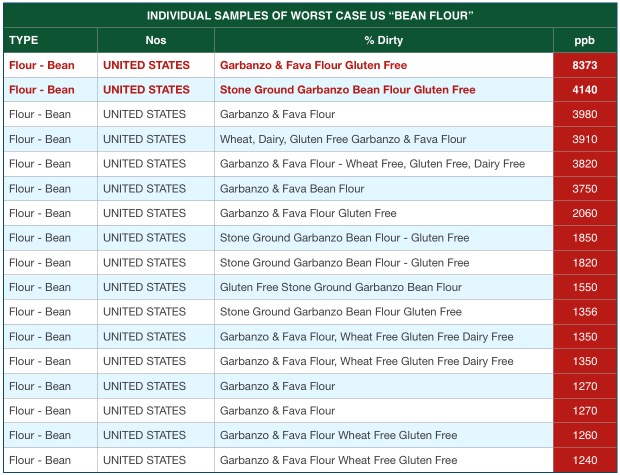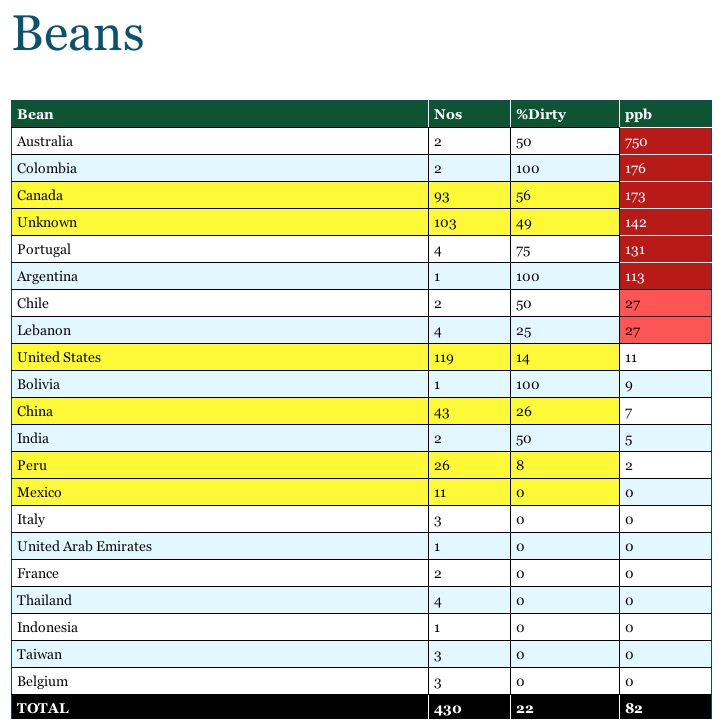Was interviewed the other day by the US based USA Prepares Show (https://www.youtube.com/watch?v=Z8W5SjHRHVI)


Was interviewed the other day by the US based USA Prepares Show (https://www.youtube.com/watch?v=Z8W5SjHRHVI)

Foods tested for glyphosate, and also foods tested for 2,4-D total over 15,000 records. The chart below gives a brief overall readings of some food types that were noted to have both glyphosate as well as 2,4-D though not necessarily from the same sample or the same sample lot. Also, the graph is not region specific and covers a global average.
More specific details will follow.
The readings for glyphosate, in blue have a much higher level of concentration compared to 2,4-D, in green, the chart was drawn on logarithmic scale rather than linear scale, to bring the two curves closer to each other, so a visual comparison and perspective could be drawn. The chart was sorted with the 2,4-D readings in ascending order from left to right i the green curve, with corresponding glyphosate readings plotted in blue for each food type. Those foods that did not have value for both chemicals have been omitted. The chart only shows average concentration of the toxins. It does not show umber of samples for each type, nor the percentage of samples that were dirty or the lower and higher extreme readings in each group.

I am determined to try my best to bring the issue of glyphosate and the Canadian Foods being the most toxic on earth, to the mainstream political discourse. I have not been too successful so far, as politicians in general as well as mainstream media, seems to have developed a case of indigestion when it comes to facing this issue.
Nonetheless, the effort continues, as part of our citizen’s duty, to be vigorously involved in our political process and try to force the candidates to address real concerns of citizens intend of talking on manufactured issues.
I have already written to three candidates of my riding, cover in earlier blogs. These were from the Liberal, NDP and BC Greens party. Two of them, the Liberal and the NDP, did not even bother to respond, which has convinced me never to vote for a candidate that ignores you.
But more than that, I have tried to lead by example so other citizens would follow and try to ask direct questions to the candidates, especially why people of western Canada are subjected to the most toxic foods on earth.
I made a few videos on this already.
The first one is here – a ten minute video about why and how I found Western Canada to be the epicentre of toxic foods.
The next, my explanation on why I wrote the book on glyphosate contamination of foods based on CFIA records, and why I do not go with the mainstream media trying to whitewash the results – an 8 minute video.
Next, a letter to the BC Greens Leader. – a 3 minute video.
And finally, a response from the BC Greens candidate from my riding – another under 3 minute video.
As I was telling someone in email today, I am convinced that our problem is rooted more to the corruption in my political process and less to do with Monsanto or any other entity, and it is our duty, as a citizen, to grab this political beast by the horn and shake it till it starts piddling.
Stay tuned.

Jacqui Miller – Greens Candidate

Scott Hamilton – Liberal incumbent

Ravi Kahlon, NDP Candidate

I self published the book ‘Poison Foods of North America‘ late in March 2017, covering my analysis of near 8,000 records of foods tested by the Canadian Food Inspection Agency, on presence of Glyphosate in food.
Meanwhile, I believe CFIA has come out with a report on its findings.
And now, I am told by friends that lots of folks are making lots of posts on the web here and there, about it, and I am told most of these reports might be projecting a different view and that the CFIA report appears to make my book look bad.
Well, I do not believe CFIA report will be in contradiction of my analysis, since we are both presumably looking at the same data. However, I fully expect our government to project an interpretation of the records so as to project an image that Canadian foods are fine. I expect it to highlight what might appear to look good, and not highlight things that are uncomfortable to talk about for a government.
The reason I wrote the book is completely different. I found alarming facts in the records, starting with
So, this book for those that wish to have a tool to navigate their way through this toxic mine field in our food web. This book is for those that have already made up their mind that glyphosate is a seriously harmful weed killing chemical to be in their food.
This book is not for discussing philosophy of poisons in foods. For those that wish to engage in philosophical discussions, they may find other places to engage in exchanging views.
Philosophy is good. But my book is not about philosophy. The attached seven minute video explains the same in my own voice.
Thanks.
 https://www.amazon.ca/POISON-FOODS-NORTH-AMERICA-navigating-ebook/dp/B06XS4Y6H2/ref=sr_1_1?ie=UTF8&qid=1491597662&sr=8-1&keywords=poison+foods+of+north+america
https://www.amazon.ca/POISON-FOODS-NORTH-AMERICA-navigating-ebook/dp/B06XS4Y6H2/ref=sr_1_1?ie=UTF8&qid=1491597662&sr=8-1&keywords=poison+foods+of+north+america
Excerpts from the book – Poison Foods of North America.
The top five origins whose food samples were the most in number as tested by CFIA are: United States, Unknown, Canada, India and China.
The chart below gives one view of the average glyphosate content in foods from these five origins, calculated as the total glyphosate in all foods divided by the number of food samples that actually contained glyphosate, excluding the clean samples, for each region. This represents the average level of contamination among the contaminated samples. The averages for all samples is the basis by which contamination levels are calculated for the rest of the book. The median line represents sort of the average, but is weighted according to the number of samples. Since number of samples are the highest from the United States, ‘Unknown” and Canada, the median is more influenced by them than by India or China. If there were equal number of samples from all these regions and more so from other countries from the world, the median would have been much lower as an indication of world average. In the chart below, this dotted red line carries a value of 204 as a whole number.

The good the bad and the ugly (median)
Thus, the United States and ‘Unknown’ are seen as sort of average, not an ideal average though. Canada is rated as bad because of having levels of contamination in its food that is 50% worse than even the median. India and China, having much lower levels of contamination, are rated good.
The table/chart below is one way to explain how foods available in Canada that originated in Canada, Unknown, the United States, India and China compare between them, with regard to glyphosate contamination.
The table gives two sets of values for each region. the chart superimposed over the table presents the same two values for each region.
These two values are average level of glyphosate contamination for each region, but calculated in under two different criteria, using two different ratio.
The bottom line, in green represents the values in the second column from left, titled “overall ppb”. This means, all the readings of glyphosate from samples from the region that had any glyphosate, was added, and then divided by the total number of samples, including samples that had no glyphosate.
The upper line, in black, represents the last column from left, where the same total amount of glyphosate was divided by only the number of samples that had any glyphosate.
In other words, the bottom line shows average glyphosate for every sample of the region, irrespective of if they were clean samples or dirty samples, while the top line is the average glyphosate content for only those samples that did have some glyphosate.
These two lines would merge in cases where a region had no clean sample at all, and all the samples contained some glyphosate, or where 100% of the samples were contaminated.
Both of them give varied but statistically significant indication for a consumer, about foods from which countries that are available in Canada, contain how much glyphosate. Foods imported from China ranked fifth number of samples, and proves to be the best food with the least amount of glyphosate in them, in either representation.

This may not be what the people of China are eating, but this is how those varieties that are exported by them to Canada, compare with the rest.
Meanwhile I made a 3 minute video on who the book Poison Foods of North America is for.
A letter sent
To: Mr. Tom Mulcair,

Tom Mulcair, NDP leader

Toxicity in North American foods compared to the rest of the world

Ravi Kahlon – NDP candidate

Canadian rye the most toxic on earth

Scott Hamilton, incumbent MLA, Liberal
I believe glyphosate will go down in history as the worst synthetic chemical this planet has ever faced, as a consequence of its perceived non-toxicity to humans and its massive use in agriculture and on people’s lawns with careless handling due to lack of awareness of its insidious, cumulative toxicity. It is destructive of human health and it is threatening extinction to multiple species, most obviously the bees and the monarch butterflies. I believe it will eventually be proven that glyphosate gets into proteins by mistake in place of glycine, and that this is the key reason for several phenomena going on in the US (and Canada?) that currently are seemingly inexplicable:
Collagen makes up 25% of the body’s protein, and glycine makes up 25% of collagen’s amino acids. Collagen in pigs and cows fed heavy doses of glyphosate in their feed is the main source of gelatin that makes its way into vaccines, gel caps, jello, and various other food products. Collagen is contaminated with glyphosate and as a consequence so are these derivatives. This easily explains why MMR vaccine today causes many more acute adverse reactions than it did in the 1990’s.
This book by Tony Mitra is priceless because it tells you which foods have the highest contamination of glyphosate, so you can change your eating habits to minimize your exposure. Glyphosate needs to be banned immediately across the globe, if we are to preserve a bright future for our children and grandchildren.
“Poison Foods of North America” provides critical information for all healthy, health conscience, infirm and struggling individuals that is necessary to prevent the deterioration in their and their families health as a result of the betrayal of the public trust that was placed in regulatory bodies.
Future historians may well look back upon our time and write, not about how many pounds of pesticides we did or did not apply, but about how willing we are to sacrifice our children and jeopardize future generations based on flawed science and failed promises just to benefit the bottom line of a commercial enterprise.
(Le français suit l’anglais) Thank you for contacting our office. All messages are read and considered. However, due to the high volume of emails received, it may not be possible to respond personally to each one. Please visit our website (http://www.ndp.ca) to learn more about our NDP team (http://www.ndp.ca/team) and latest news (http://www.ndp.ca/news). Thank you again for taking the time to share your ideas, concerns and insights. Your input helps us with our work. All the best, Office of Tom Mulcair, MP (Outremont) Leader, New Democratic Party
A question asked of the election candidates of my riding
Sections of Excerpts from the book – POISON FOODS OF NORTH AMERICA, covering food samples tested from the rest of the world.
There are more than 1,100 records of foods tested for glyphosate by CFIA that originated from countries other than Canada and the United States. For this book, I have grouped them as the “Rest of the world”. There are sixty six countries in this group.
There is a reason why this grouping was done by me. Foods produced in the rest of the world, exceptions aside, are an order of dimension better than similar foods grown in English speaking North America, with respect to slow poisoning from glyphosate.
Before folks get into a knot on my use of the term ‘poison’ with regard to glyphosate, I have clarified my position in the book already, which are, briefly as follows
A truncated master list of the 66 countries with respect to glyphosate in food, as tested by CFIA, is given below. This section only shows the top half, due to size and bandwidth limits. In the book, the full list covers three pages.
The table covers all the rest of the world, outside of English Speaking North America. The portions shown here are the worst group on top, and the ‘caution’ group in the middle. The top countries and their average level of glyphosate contamination are highlighted in read at left and right column. Countries that have a sample number of ten or more, and therefore might provide a better statistics are highlighted in yellow.
IN the worst group, with samples of ten or more, are Turkey, Poland, Greece and Lebanon. These are the real bad apples, followed by a few others with fewer samples.
The middle group, that are not as bad as the worst and not as good as the best, are highlighted yellow. Relevant countries here are Japan, Italy, India, and Korea.

Countries in the good range ( not included in the table above) are many, which is a very healthy sign for the rest of the world. These countries are Bolivia, China, Chile, Mexico, Spain, Peru, South Africa, Ecuador, France, Thailand, Netherlands, Guatemala. The first countries in this list, i.e. Bolivia have glyphosate content closer to 5 and the last country, Guatemala have zero.
Leaving the bad apples of the rest of the world, let us go back to Australia for now. It occupies the highest rung for the nastiest average contamination in the rest of the world, although with only 4 samples. Further, with only 25% of them contaminated, with an average that is so high, it implies that only one out of those four were bad and that one must have had four times the average value. in fact, that one sample was bad enough to turn Australia into a potential nastiest producer of food outside of Canada and USA. So, one might dig into it a bit and figure out what is going on there.

There it is. This Mung Bean is the culprit that places Australia at the top of the nastiest of nasty list of the rest of the world, for producing glyphosate laden food.
But, far as I know, Mung bean, or Moong Dal, is a lentil of India and not particularly common dish for non-Asians. So what is this Mung Bean, and so highly toxic to boost, doing as an Australian produce ?
I do not know the full answer, but can hazard a guess. India is a densely populated country, and is upwardly mobile in the sense that it is finally shedding its abject poverty and malnutrition through two centuries of western colonization that squeezed it to bare bones, and is just now beginning to eat better. In the process its domestic production is unable to cope with rising demand, and with money in its pocket, India is beginning to import some foods from outside.
This has caught the attention of countries with agricultural land to spare and attractive markets to capture.
Enters countries like Canada, USA and Australia. Each of them start growing lentils. While the US grown lentils have relatively lower levels of glyphosate, those from Canada are really high, as per CFIA records. And now it appears that the single sample from Australia is also sky high in unwanted toxicity. One also wonders how this sample ended up in Canada ? Is it being imported from Australia into Canada? Why? Is some store importing it because it is cheaper than local lentils? Who is growing it in Australia and why?
Perhaps someone will figure this one out and educate us. My suspicion is that it is grown for India and for people of the Indian diaspora, who are quite well settled and reasonably affluent in North America, Europe, the Middle East and even Australia, all of whom might be the secondary target markets for these lentils.
Of course, lentils from Australia, and if these are designed to end up slow poisoning people in India or the Indian diaspora living across the world, is neither the main nor the only story for this section on the “rest of the world”. So readers might just read on.
Canadian Food Inspection Agency (CFIA) had nearly 8,000 records of foods tested for presence of glyphosate, which I came to acquire a copy of after years of working on this issue with various levels of the Canadian Government going back some number of years, to the time when Mr. Harper was the Prime Minister. My interactions started with the issues that Canada at the time did not even have a lab that would test foods for glyphosate, which I considered to be an outrageous and unacceptable state of affair. Thankfully, within a year, labs started getting themselves accredited for testing foods for glyphosate, more or less concurrent with the time when World Health Organization classified glyphosate to be a probable carcinogen.
While this matter was kept outside of the media or Government outlets, i was fully aware of a scheme going on to test foods available in Canada, of both Canadian and imported kind, for glyphosate. This started my next level of effort with the Government to get my hands on the food test records. In between all this there has been letters, meetings, petitions and motions initiated by me and sent to Health Ministers spanning two governments, demanding disclosure on various aspects on glyphosate, from its approval for agriculture, to setting of MRLs, to its aerial use over forests, prairies and watersheds. Those details may not have a direct relation with this blog, but all these efforts and years of involvement brought me to where I was three months ago, sitting on a huge pile of test records on foods collection in Canada, and around a thousand and five hundred of those records involved foods originating in the United States, and a similar number for foods grown in Canada. India and China provided the most samples after USA and Canada.
All these records were scanned by me and converted to editable text and numbers using optical character recognition software, and error corrected. Finally, multiple giant spreadsheets were created to sort through the data for analysis. That prompted me to write and publish an online e-Book to alert the people. I named it “POISON FOODS OF NORTH AMERICA”.
The book is over 300 page long and has more than 300 tables, along with charts and images. Many of the tables give the actual raw data with regard to glyphosate content and description of the food sample, its origin etc.
Some of the findings were as expected while some are totally unexpected, and often shocking.
Here are a few examples:

Foods from over sixty nations have been tested, but not all of them contributed large number of samples. However, a few nations did have high sample depth, USA is among them.
The table here was truncated from a long one, with each and every type of food that was recorded by CFIA to have come from the United States. Then, for now, all food types that hat had less than 10 samples were set aside.
Of the remaining samples, how many belonged to which food type was entered in the second column from left, against each food types. How many of that food type proved ‘negative’ or had to glyphosate, was checked. These two figures allowed calculations on what percentage of the samples were dirty (proved positive in glyphosate screening). Then all the glyphosate and AMPA values were added and then divided by the total number of samples for each food type, to get average ppb contamination level, which is shown in the last column.
Then the table was sorted by ppb values in descending order, and included as the first item within the subchapter of foods from the United States.
So this table is the dirty dozen of American foods.
We shall then proceed with looking at more details of some of the dirty dozen that have high glyphosate levels and high enough sample depth to provide a glimpse of what is happening with toxicity in US grown foods.

The top two items in the second table above are in violation of the MRL (Maximum residue Limit) set by the Canadian Government. What is interesting to ponder, or perhaps correspond with the authorities about, is what happens with such violations are noted. Ideally, the product should be withdrawn. Public should be notified and warned not to buy or consume it. Those that already bought this item should be advised to return it to the store and get a refund. The producer should be prosecuted. The issue should be out on mainstream media for public awareness.
None of that, as far as I can remember happened or happens. I do not remember a single instance with I was aware of such foods being recalled or public warned.
So, are we to suppose that those MRLs which are themselves set arbitrarily without providing any proof of their authenticity, are also not being implemented? In our food safety mechanism we might have a reproduction of the “wild west”.
In the case of violations on foods imported, in this case from the US, should the US Government and public also not be notified? Is anybody from the US aware of this situation?
I use the term toxic and poisonous interchangeably to mean the same thing, and I deny the mainstream any right to control the meaning of the terms toxic or poisonous with regard to glyphosate.
As long as the public is denied independently verifiable proof that glyphosate in food is safe at any level, over the lifetime of animals consuming it even in low dose, to me, all talks of glyphosate being safe is worth little more than magic or voodoo.
Mainstream can continue to consider glyphosate as safe, and I shall continue to believe it is the most dangerous synthetic chemical to have entered our food system and threatens to undo the long term health of the human society as well as all flora and fauna of the land.
And thus, the table above is the opening section of the “dirty dozen” of US foods. We shall also have more such tables covering the remaining items in dirty dozens list from USA, Canada, Unknown, and some other countries.
The book is already online, but constantly being improved, proof read, new tables, charts, subjects and value added. All updates should be free for legal owners of previous copies. However, there is a catch. Apparently, free updates are decided on case by case basis by Amazon after receiving an application from the author. Standard guidelines provided by Amazon mentions that additional chapter and added pages do not qualify for free access to later versions of the book by folks that bought an earlier version. I did not know that till I started inquiring with Amazon. Now I am trying to impress upon them that this book is a reference and analysis of the most controvercial herbicide in our food system and there is no other book of this kind, covering data that is not available to anybody else at this point of time. And later versions cover critical data on foods form the US, a significant producer of foods that are contaminated with this herbicide. I hope to impress upon them to make a difference and allow free updates to owners of earlier copies.
Otherwise, I would suggest that potential readers might like to wait for about a weak or two before purchasing the book. For all these confusions, the price of the book is lowered temporarily by a few dollars. It will be back up to around $ 9.99 as soon as sections covering US foods and foods from China and India are completed. Target is by the first week of April, 2017.
The book can be found in Amazon, NAMED “Poison foods of North America”. Book cover, designed by me, is shown here with the link.
I also made a three minute video on the book, as shown below.
Lastly, this book is not designed to add to the debate on if glyphosate is safe and at what level. I have no interest to join any such debate. I am uninterested in the opinion of the glyphosate supporting industry and their supportive political and media outlets. I live in a free country and the meaning of any word or term such as toxic or poisonous, is not owned by the industry. The meaning is not even etched in stone and changes with times depending on perception by the people.
So, the mainstream can continue to harp that glyphosate is safe. I shall continue to believe it is dangerous and unsafe at any level of concentration, until proven otherwise by independent verification and the regime of secrecy around it has been dismantled.
So who is this book for? It is for those that have, like me, already decided that glyphosate is a seriously harmful molecule in their food web and they would rather find a way to avoid it right now. Those are the people this book is for.
The mainstream science, media, political class and the regulatory authority has lost public trust on this issue. This book is not aimed at influencing their opinion. This book is for the people – the rest of us.
Dr. Vallianatos, retired US-EPA scientist and author of the book “Poison Spring” read and reviewed this book on Huffington Post. Link.
The eBook ‘POISON FOODS OF NORTH AMERICA” is up on Amazon now. It sells under the the banner of a Kindle edition. It describes how a person could adapt and modify one’s eating habit in order to avoid being slow poisoned by a steady dose of glyphosate. The analysis is based on 7,800 odd records of foods tested by the Canadian Food Inspection Agency (CFIA), of which I got a copy of the raw data of the tests.
As a result there has been some confusion among potential customers, that they might be forced to buy a hardware device from Amazon, in order to read these books. Well, as it happens, that is not true. Amazon sells a free app for various devices. I have found reading the book on my computer to be the most pleasing because of the lovely appearance of the tables.
This blog is written for those who have a doubt if they can read the book “POISON FOODS OF NORTH AMERICA” if do not have a kindle reader device, and think they cannot read this book without that device. Many are reluctant to buy this device only to read one book. This blog is for them and the purpose is to assure them that they do not need to buy an additional device just for one book.
A kindle app logo looks like the one at the right. It is available free of charge at Amazon, and there is an app for each kind of device in your home, such as a computer, or a tablet or a smart phone etc.
The book cover is shown below. I initially thought this would be a temporary cover and I shall move on to a better looking cover later on. But, I think human brain associates some images with the matter represented by that image. In other words, this book cover image is now linked with the book on glyphosate in Food as tested by CFIA. So I shall let the cover stay for now.
The book, if read through my MAC laptop using the kind app, looks quite pleasant. One of the chapters are shown below as a sample.

Finally, I made a four minute video showing how it actually looks on my mac laptop.
Hope this will assist folks.